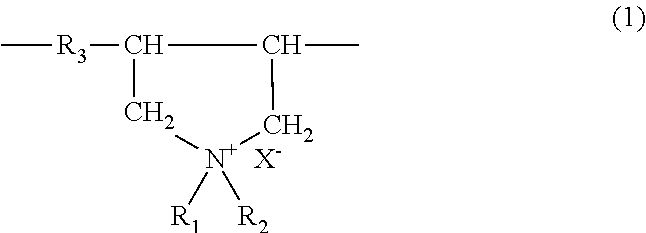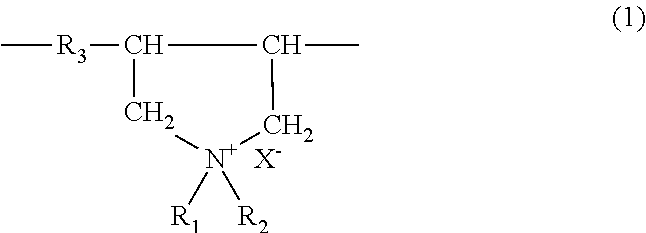Pretreated cation-exchange resin, treation method of the resin, and mixed bed with cation-exchange resin
a technology cation exchange resin, which is applied in the direction of cation exchanger materials, water/sewage treatment by ion exchange, ion exchangers, etc., can solve the problems of agglomeration, reducing the ion exchange capability of anionic exchange resin, and mutual adhesion of resins
- Summary
- Abstract
- Description
- Claims
- Application Information
AI Technical Summary
Benefits of technology
Problems solved by technology
Method used
Image
Examples
embodiment 1
[0038 is as follows.
[0039]A column was packed with one liter of strongly acidic cationic exchange resin (proprietary name: Amberjet 1500, hydrogen type) and the column was then filled with deionized water. A total of 60 mg of poly (diallyl dimethylammonium chloride): [PADMAC] (product of Nalco Chemical Co.) having number average molecular weight of 100,000 was dissolved as water-soluble cationic polymer electrolyte in deionized water and then circulated into aforementioned column. This was stirred for one hour at 60° C. under air mixing, followed by adequate washing with deionized water to derive strongly acidic cationic exchange resin treated with water-soluble cationic polymer electrolyte.
[0040]Agglomeration Test: Agglomeration tests pursuant to the method stated in paragraph 0022 of Japanese Kokai Publication Hei-2003-176371 were carried out on the resulting water-soluble cationic polymer electrolyte-treated strongly acidic cationic exchange resin. The results are presented below...
embodiment 2
[0045 is as follows.
[0046]The same operations as in Embodiment 1 were repeated except for the use of 100 mg of poly diallyldimethylammonium chloride instead of the 60 mg of poly diallyl dimethylammonium chloride having number average molecular weight of 100,000 that was used in Embodiment 1. That derived cationic exchange resin whose surface was coated.
[0047]Comparative Examples 1 to 4 are as follows.
[0048]The same operations as in Embodiment 1 were repeated except for the use of compounds presented in Table 1 instead of the 60 mg of poly diallyl dimethylammonium chloride having number average molecular weight of 100,000. That derived cationic exchange resins (the resin of Comparative Example 1 was untreated) whose surfaces were coated.
[0049]
TABLE 1Embodiment or ComparativeType of water-soluble cationic Amount Examplepolymer electrolyte(mg)Embodiment 1PADMAC60Embodiment 2PADMAC100Comparative Example 1(none)—Comparative Example 2poly(vinyl pyridine)ester60Comparative Example 3polyvin...
PUM
| Property | Measurement | Unit |
|---|---|---|
| mean volume particle diameter | aaaaa | aaaaa |
| temperature | aaaaa | aaaaa |
| temperature | aaaaa | aaaaa |
Abstract
Description
Claims
Application Information
 Login to View More
Login to View More - R&D
- Intellectual Property
- Life Sciences
- Materials
- Tech Scout
- Unparalleled Data Quality
- Higher Quality Content
- 60% Fewer Hallucinations
Browse by: Latest US Patents, China's latest patents, Technical Efficacy Thesaurus, Application Domain, Technology Topic, Popular Technical Reports.
© 2025 PatSnap. All rights reserved.Legal|Privacy policy|Modern Slavery Act Transparency Statement|Sitemap|About US| Contact US: help@patsnap.com


